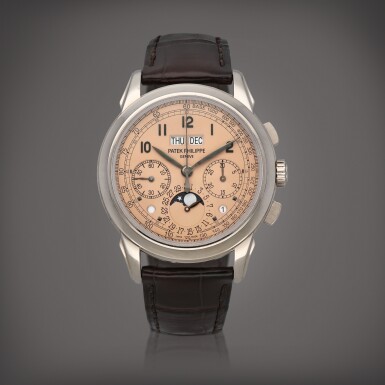Important Watches
Important Watches

Patek Philippe
Reference 5270G-001 A white gold perpetual calendar chronograph wristwatch with moon phases, leap-year and day/night indication Circa 2011 | 百達翡麗 | 型號 5270G-001 白金萬年曆計時腕錶備月相、閏年及晝夜顯示,製作年份約 2011
Auction Closed
November 9, 01:29 PM GMT
Estimate
70,000 - 140,000 CHF
Lot Details
Description
Patek Philippe
Reference 5270G-001
A white gold perpetual calendar chronograph wristwatch with moon phases, leap-year and day/night indication
Circa 2011
百達翡麗
型號 5270G-001 白金萬年曆計時腕錶備月相、閏年及晝夜顯示,製作年份約 2011
Dial: salmon
Calibre: cal. 29-535 manual winding, 33 jewels
Movement number: 5’587’384
Case: 18k white gold, screw-down sapphire crystal display case back
Case number: 4’548’673
Closure: brown Patek Philippe alligator strap and 18k white gold folding clasp
Dimensions: 41 mm diameter
Signed: case, dial and movement
Box: yes
Paper: yes
Accessories: Patek Philippe Certificate of Origin, instruction manual, additional silvered dial, leather bifold and presentation case with outer packaging
